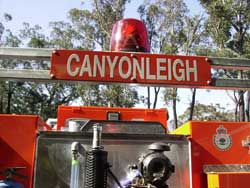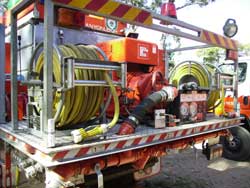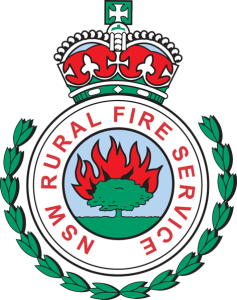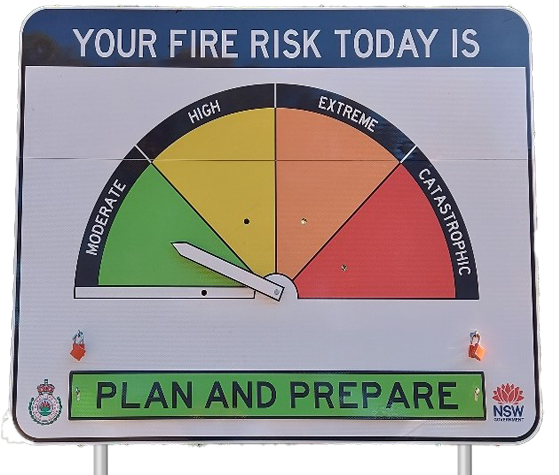The “Brigade” was first formed in 1932 with its early composition being made up of farmers who fought fires with whatever equipment they possessed. In 1957 (or 1958), after a fire started on Oscar Murray’s property (now part of “Glencoe” on Inverary Road), which burnt up the swamp and then threatened the Penrose Pine Forest there was strong lobbying for a fire tanker for Canyonleigh.
Council subsequently provided the brigade with a Ford Blitz (formerly used at Sydney Airport).
These were converted army trucks left over from the Second World War. They had a top speed of 30 mph as long as they were empty with the wind behind them and they were going downhill. They seated 2 people in the front cabin but could carry people standing on the back.
The fire fighting unit came with a huge asbestos suit for rescues (if you could walk in it) and was fitted with a Wisconsin pump (as good as any today).

A later model Blitz to the one the Brigade owned. The version the Brigade had was yellow in colour
The only problem was when the Blitz got hot and stalled or stopped you had to crawl under the dashboard and cross a set of points with a screwdriver while someone else hit the starter! The Blitz was parked at the Quigg’s property and George Quigg took it for runs to keep it charged. At the time it was the best tanker in the Shire other than the equipment operated by Forestry.
In 1965 devastating fires swept the district and it proved a trying time for Canyonleigh. After looking at offers of sites for a fire shed from the Quigg’s, Clayton (“Foxgrove”) and Burts it was decided to site the proposed new fire shed on the water reserve next to the Mulready quarry entrance. It was funded fifty percent by council with the local community and brigade members contributing the balance. In addition to a new shed (which was a single garage) there was also a push in the shire to update fire tankers. Canyonleigh and Wingello brigades were then the first Brigades in the Shire to receive new purpose-built Bedfords.
These “Mark III Bedford Single Cab” trucks were fitted with a tank and pump on the back tray. There was a metal bench seat on the back tray which was uncomfortable for members to sit on after about 5 minutes. It had a Briggs and Stratton Brigade Master petrol pump. The Bedford held fond memories for those who used it as it was very reliable although it could be temperamental in starting. Its major disadvantage was it had no air brakes making stopping somewhat problematic. Generally this was not an issue as with a top speed of 80km/h, at which it was absolutely screaming, it rarely got enough momentum to make stopping difficult.
George Quigg remembers during the1979 fires that twice the clutch plates were torn out. Fortunately though Dick Stroud, a local who was also a mechanic and Dick Wood Davies discovered that the new model 1979 Holden had the same clutch. Cannibalising a couple of local vehicles they were able to repair the Bedford overnight and get it back into action.
In 1976 the Brigade received its second vehicle, a Land Rover Table Top. It had a 600 litre tank on the back equivalent to the “Cat 9” class used today. Generally it was garaged at the Captain’s house and was used as a first response vehicle and often used to locate fires. Nowadays this function is performed by spotter aircraft; however they lack the versatility this vehicle possessed, as it carried water to put out a fire once discovered.
Following the 1979 fires the Brigade was issued with 2 small trailer tankers that were towed behind the Land Rover. Stored locally on farmers properties they were often used for weed spraying in the off season.
By 1986 the Brigade had a second tanker known as Canyonleigh 2, a 6 wheel drive International which was also ex-army. This was affectionately known as “Shipey’s truck” after the Deputy Captain Russell Shipway as he was so protective of it he refused to let anyone else drive it. It had its challenges when driving in four wheel drive. It required 2 people with one person holding it in gear as it had the most disconcerting habit of jumping out of low range. A refinement added later was the fitting of a chain to hold the gearstick in place. Being petrol powered it was also prone to having the fuel vaporise thus making it difficult to start. George Quigg recalls during one fire watching one member wrap the carburettor in a rag and pouring water on it, to cool it down.
A second, larger shed was built at this time to house this truck. Like the smaller shed, backing the truck into it was a dangerous exercise. Located just 5m back from the road, with just enough room to park a truck out the front, the shed was located in the dip of a hill meaning oncoming cars had no warning a truck was pulling in or out. The safety was slightly improved when a flashing light, on a 3m pole, was installed.Safety was still reliant on the driver managing to reverse the truck into the shed in one lock. To make matters even harder to get the Land Rover into the smaller shed the driver had to bend the mirrors back.
The shed also had a siren designed to warn the local residents of an emergency situation. This siren was only audible though for about 300m rendering it effectively useless.
Tim Street (long time resident of Canyonleigh) writes “I think from memory that the siren was installed when the shed was built and that it could be heard over at “Quiggs” on Foxgrove Rd but not a lot further. My father tested it from “Cowabee” but was not sure about its use at that range. Our homestead had a bell tower and I know that the old bell (originally from Coonamble Fire Station and presented to my Grandfather” was able to be heard from about 2 miles away.”
In 1990 a second Bedford truck was received which was stored at George Barnett’s property on Bangadilly Road. The plan at this stage was to build a northern shed on a parcel of land located at 1800 Tugalong Rd in order to improve response times at the northern end of the Brigade’s area. By 1996 though the decision was made by the RFS that the vehicle was not warranted and it was returned to town. Further enhancing the capability of the Brigade was the issue of a 600 gallon trailer which was stored at Nandi Station. Due to its size and weight though it required a tractor to tow it and it was only in service for a few years.
In 1991 the 1976 Land Rover was replaced by a diesel powered Land Cruiser. For the first time the Brigade had a vehicle that used less oil than petrol. Fitted with a diesel pump rather than a petrol one it was overall a much safer vehicle. This vehicle was in operation until 1999. When it was removed the “first strike” capacity of the brigade to quickly find and put out a fire was significantly reduced.
The first “modern tanker” was the Cat 7, a 1000 litre truck which was received in 2001. It replaced the old International which gave 15 years of solid service.

The Cat 7 monitoring a Hazard Reduction
In 2002 a “Category 1 truck” arrived, which carried 3000 litres of water. After 30 years of faithful service the Bedford was finally retired. The Brigade had now entered an era where its vehicles are on a 10 year replacement schedule.

The original Cat 1 in a pre season street parade
Originally housed in the old shed these vehicles were moved in 2006 when the new shed was completed. The new shed was built using Council funds; however the interior fit out was only made possible by volunteer time and local donations. The old shed was dismantled and sold, it is rumoured it still exists somewhere in Canyonleigh.
In 2011 two new vehicles arrived with the older trucks continuing their service with Brigades in Western NSW.
BRIGADE EQUIPMENT
Over the years equipment has improved considerably. In the early days volunteers turned up in whatever sensible clothing they possessed, usually leather shoes and cotton clothing. Head protection was a leather hat and gloves were worn when people had them.
The first issue of personal protection equipment or PPE occurred in 1977 when overalls were distributed. Still available they are popular with older members but they were replaced with the 2 piece suit in 2000.
Today Brigade members are issued with gloves, helmets, leather boots with fire resistant soles, fire resistant goggles and flash hoods.
Early model fire equipment included the “Rega knapsacks”. These were uncomfortable and difficult to use. George Quigg can remember using them during the 1965 fires alongside army personal sent down to help. Somehow though, the army managed to only ever carry theirs 50 metres before they were empty with local, somewhat more committed, members carrying theirs several hundred meters before they ran out of water. More commonly they were used in spraying weeds on members’ properties.
The limitations were never more graphically illustrated in the 1979 fires as a bulldozer threw a spark, after hitting a rock, whilst trying to put in a fire trail. Allow the dozer was being followed by one of the Loseby family, on a motor bike with a knapsack of water on the back, the spark was unable to be contained and a new front 3km more advanced than the original one, was accidently lit.
Replaced by plastic knapsacks which were only marginally more comfortable they are still rarely used. Today the carrying racks for the plastic knapsacks on the trucks are used for carrying extra jerry cans of drip torch fuel. This increases the amount of drip torch fuel on the Cat 1 truck from 30 litres to 90 litres. The Brigade has also modified the Cat 1 to carry 4 drip torches instead of the standard issue of 2 drip torches.
The canvas flapper or beater while no longer used is still a very useful tool for dry fire fighting. More commonly used before pumps and water equipment became available it was sometimes made out of leather or any material that was available.
Occasionally though, depending on what it was made out of, it had the most disconcerting habit of throwing burning material behind you and making more fire than it was putting out!
Easily made and therefore accessible, many properties made their own beaters. The beater works by denying one of the three elements that fire needs to maintain ignition, air. Water works by cooling the fire thus removing the heat. The third method used to control fire is hazard reduction which is the process of removing or reducing the fuel source.
Old timers still swear though that the most effective tool they ever had was simply a wet hessian sack.
Safety is a very important part of fire fighting. During major fires an ambulance is deployed to the staging area and the Brigade is also fortunate to enjoy the support of the Canyonleigh SES volunteers and vehicle.
Catering has always been vital in big fires. Today the District has its own catering van which is deployed to any fire that goes longer than 24 hours. In this first 24 hour period though, the Brigade is responsible for its own catering. In the early days the Brigade did not even have the advantage of bottled water this problem being solved by the use of large water urns. One of the first of these urns was donated by Moss Vale Lions Club. Dating back to 1965 the urn is has spelt Canyonleigh as Canyan Leigh.
Tim Street believes this to be a spelling mistake by the Lions Club. He writes “These urns were donated after the 1965 fires and sat in our sheds and meat house for years until I returned them to the old fire shed in about 1997. The original Parish Maps showed the spelling as Canyonleigh but some of the older folk used the other spelling – probably due to historic inaccuracy. The old property known as “Keebarbin” was in fact the “Canyonleigh Post Office” which closed either in the late 40’s or early 50’s. We had the sign in our shed for years but I do not recall what became of it. However, it was spelt as currently used. As were the original Land Titles – from vague memory.”
Modern maps are supplied by the RFS and are also available online or through smart phones. The Brigade also carries a GPS unit. This allows our fire trails to be recorded. This information is emailed to Fire Control in Mittagong who can print out a topographic map complete with the updated fire trails.
While the Brigade carries 3 types of radios it does not own a mobile phone as the RFS will fund the rental on either a landline or a mobile but not both. Call costs for non operational issues regardless of the method are paid by the Brigade.
BRIGADE CAPTAINS LIST
Harold Casburn 1932 to 1934
Toby Burt 1934 to 1935
Horace Quigg 1935 to 1965
Alan Hobbs 1965 to 1968
Harry Taylor 1968 to 1977
George Quigg 1977 to 1987
Ron Stahl 1987 to 1995
Tim Street 1995 to 1998
Peter Attreed 1998 to 2004
John Kay 2004 to 2010
Mark Pearson 2010 to 2019
Brett Bannerman 2019
Credits: This list was complied using the memories of notable people throughout the Brigades history such as George Quigg, Ron Stahl, George Barnett, Tim Street, Peter Attreed and John Kay. It was cross referenced against Brigade and Fire Control Records. It is considered to be the most accurate list that could be compiled.
Reviewed by Amanda Garske(Firecom), Peter Attreed, John Kay,Tim Street, Frank Downes, George Barnett, George Quigg


